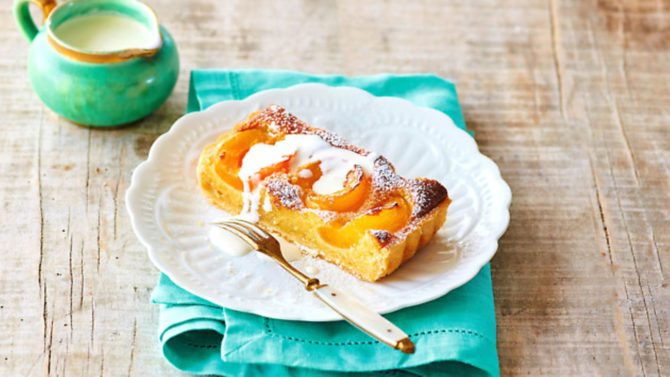Recipe: tarte aux abricots

Indulge in a classic French pastry by following our recipe for tarte aux abricots
Can there be a more beautiful fruit than the apricot? Not only do they look striking with their pink blush, they feel as soft and sensuous as velvet. In fact, throughout its history, the apricot has inspired many people, including artists such as Cézanne and the leading art critic of Victorian England, John Ruskin, who wrote of the fruit, “shining in a sweet brightness of golden velvet”. However, it is important to note that the pinkish-red bloom on an apricot is a sign that the fruit is not yet fully ripe – not perhaps so good for eating fresh, but actually rather perfect for a tart.
The apricot is a member of the rose family and is related to plums, peaches and cherries. Thought to have originated in China where it has been cultivated for more than two thousand years, its popularity gradually spread and apricots are now grown commercially across the globe including in France. In fact, France is said to be the world’s fifth largest producer of apricots, which grow in abundance in the temperate climate found in the south-east corner of the country including Rhône-Alpes and Provence, and into Languedoc-Roussillon.
Like the fruit itself, recipes for apricots are plentiful, including, of course, tarte aux abricots. Traditionally this dessert included the use of the stones, which were crushed and scattered over the pastry base along with ground almonds, adding an extra intensity and slightly bitter almond flavour.
My favourite type of tart has a layer of frangipane – a nutty cream-like paste made with sugar, eggs and ground almonds – but you will find many variations of this around France. Some are cooked in a custard base, while others are simply arranged over ground almonds on a puff pastry round and baked until golden. The base can also be a sweetened bread dough, where the tips of the fruit are lightly charred, before then being glazed with homemade apricot jam.
I’ll never forget my first trip to Paris, staring through the window of an elegant pâtisserie in the Marais. In among an array of jewel-like pastries was perhaps the must luscious of all, a tarte aux abricots with golden tipped apricots atop a thin pastry base, set out in concentric circles and glossed with a jam glaze – simply heavenly.
RECIPE
Serves 8
INGREDIENTS
I have made this in a 12x32cm rectangular tart tin, but you could also use a 23cm round tin.
• 1 x 280g packet shortcrust pastry
• 100g unsalted butter
• 100g caster sugar
• 2 eggs, lightly beaten
• 1 tsp vanilla extract
• 100g ground almonds
• 12 medium-sized fresh apricots, halved and stoned
METHOD
1. Preheat the oven to 200°C/180°C fan. Place a baking sheet on the middle shelf to get hot (this will help crisp up the base of the tart). Unroll the pastry and fold in half and then in quarters. Roll out on a lightly floured surface to form a rectangle a little larger than a 12x32cm fluted tart tin. Press well into the base and sides allowing a little pastry to hang over the edges. Prick the base with a fork and chill for a further 20 minutes.
2. Place a sheet of baking paper in the pastry-lined tin and fill with baking beans, then bake for 15 minutes until the edges of the pastry are golden brown. Remove the baking paper and beans, and leave the pastry shell to cool. Once cooled, use a small sharp knife to trim the overhanging pastry so it is flush with the edges of the tin.
3. Place the butter and sugar in a food processor and blend until smooth, then add in the eggs, vanilla and ground almonds, and blend until evenly combined. Spoon the mixture into the pastry shell, and press the apricot halves well down into top. Transfer to the oven and bake for 40 minutes until firm and golden (cover with foil if the pastry starts to get too dark).
4. Remove from the oven and allow the tart to cool for 30 minutes or so. Serve at room temperature with a little fresh cream.
More recipes: cherry clafoutis and cheese soufflé
Share to: Facebook Twitter LinkedIn Email


